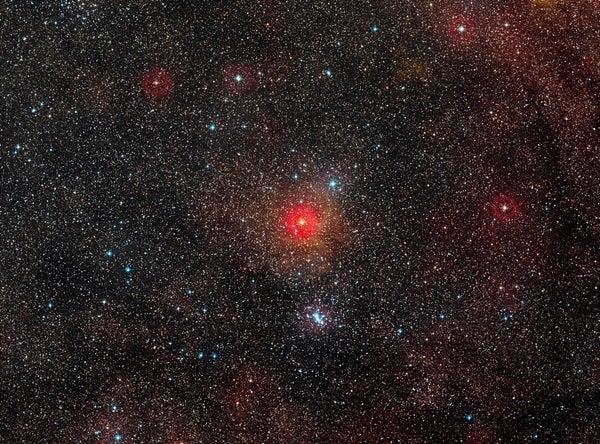Using ESO’s VLTI, Olivier Chesneau from the Observatory de la Côte d’Azur in Nice, France, and an international team of collaborators have found that the yellow hypergiant star HR 5171 A is absolutely huge — much bigger than was expected. This makes it the largest yellow star known — 50 percent larger than the famous red supergiant Betelgeuse — and about 1 million times brighter than the Sun.
“The new observations also showed that this star has a very close binary partner, which was a real surprise,” said Chesneau. “The two stars are so close that they touch, and the whole system resembles a gigantic peanut.”
The astronomers made use of a technique called interferometry to combine the light collected from multiple individual telescopes, effectively creating a giant telescope up to 140 meters in size. The new results prompted the team to thoroughly investigate older observations of the star spanning more than 60 years to see how it had behaved in the past.
Yellow hypergiants are rare, with only a dozen or so known in our galaxy — the best-known example being Rho Cassiopeiae. They are among the biggest and brightest stars known and are at a stage of their lives when they are unstable and changing rapidly. Due to this instability, yellow hypergiants also expel material outward, forming a large extended atmosphere around the star.
Despite its great distance of nearly 12,000 light-years from Earth, the object can just about be seen with the naked eye by the keen-sighted. HR 5171 A has been found to be getting bigger over the past 40 years, cooling as it grows, and its evolution has now been caught in action. Only a few stars are caught in this brief phase where they undergo a dramatic change in temperature as they rapidly evolve.
By analyzing data on the star’s varying brightness using observations from other observatories, the astronomers confirmed the object to be an eclipsing binary system where the smaller component passes in front and behind the larger one as it orbits. In this case, the companion star orbits HR 5171 A every 1,300 days. The smaller companion is only slightly hotter than HR 5171 A’s surface temperature of 9000° Fahrenheit (5000° Celsius.)
“The companion we have found is very significant as it can have an influence on the fate of HR 5171 A, for example, stripping off its outer layers and modifying its evolution, Chesneau said.”
This new discovery highlights the importance of studying these huge and short-lived yellow hypergiants, and it could provide a means of understanding the evolutionary processes of massive stars in general.










